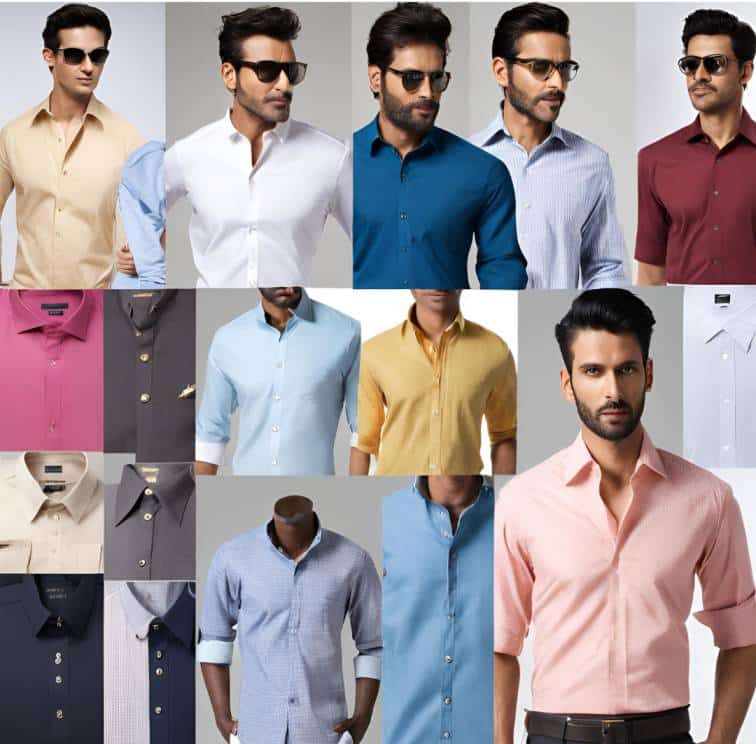Casual to Classic: Shirt Styling Made Simple
Shirts are a staple in men’s fashion, offering endless versatility for every occasion. From casual outings to formal events, the way a shirt is styled can elevate any look, making it essential to understand the nuances of each setting. Whether it’s a simple T-shirt for a laid-back day, a crisp button-down for the office, or a tailored dress shirt for a wedding, mastering shirt styles can transform your wardrobe. This guide explores how to style different types of men’s shirts, balancing comfort with elegance, to ensure you’re always dressed appropriately and confidently for whatever the occasion demands.
Decoding Shirt Types
- Casual Shirts:
- T-Shirts and Henleys: Known for comfort, T-shirts and Henleys are perfect for relaxed settings. They come in various fits, from loose to slim, and can be layered or worn alone.
- Casual Button-Downs: Often made from lighter fabrics like cotton or linen, casual button-downs are great for weekends or informal gatherings. They pair well with jeans or chinos.
- Business Casual Shirts:
- Polos: Ideal for a laid-back office look, polos blend comfort with a polished appearance. They can be tucked into slacks or worn with khakis.
- Dress Shirts (Relaxed Fit): Business casual dress shirts are typically solid-colored or minimally patterned, offering a professional yet approachable look. Paired with slacks or dark jeans, they’re versatile for both work and after-hours.
- Formal Shirts:
- Dress Shirts (Structured Fit): Essential for formal occasions, these shirts are often white or light-toned and feature a tailored fit, with options like French cuffs. It is ideal for pairing with suits and ties.
- Tuxedo Shirts: Specifically designed for black-tie events, tuxedo shirts have details like pleats or studs and complement evening wear.
Color and Pattern Choices
- Solid Colors: Timeless and versatile, solid-colored shirts (white, navy, black, grey) are essential for both casual and formal looks. White shirts, in particular, are a classic choice for formal settings, while navy and grey offer a refined yet understated appearance for business or smart casual outfits.
- Pastels: Soft hues like baby blue, light pink, and mint green are ideal for spring and summer, bringing a refreshing touch to your wardrobe. These colors work well in both casual settings and semi-formal events when paired with complementary trousers or blazers.
- Stripes: Vertical or horizontal stripes can add dimension to your outfit. Thin stripes are ideal for a professional look, while bolder stripes can add personality to a casual or semi-formal outfit. Avoid overly loud patterns in formal settings.
- Checks and Plaids: A casual pattern, checks, and plaids work best in laid-back settings, like weekends or casual offices. For a more polished look, choose smaller, subtle patterns.
- Patterns and Prints: For a bold look, patterns like florals, polka dots, or abstract designs can express individuality. Though they’re best for casual events, keep them understated in business or formal environments.
Accessorize Like a Pro
- Watches: A stylish wristwatch adds sophistication and function. Opt for a classic leather strap for formal occasions or a metal band for a polished business look. Sportier watches can complement casual shirts for a relaxed vibe.
- Belts: A belt is essential for both style and practicality. Match your belt with your shoes—leather belts for formal or business outfits, and fabric or casual leather belts for laid-back looks. Ensure the belt is proportional to your body frame.
- Ties: Ties are vital for semi-formal and formal events. Choose a silk tie in solid colors or subtle patterns for professionalism. For a more relaxed vibe, consider knitted or linen ties. A bow tie can bring a hint of elegance to both formal and semi-formal events.
- Pocket Squares: For formal shirts, a neatly folded pocket square adds flair to blazers or suits, elevating your look. Stick to simple folds for understated elegance or more intricate designs for bold style statements.
- Sunglasses: In casual settings, a sleek pair of sunglasses can complete your look, protecting your eyes while adding an element of style.
Layering Techniques
- Blazers and Jackets: A well-fitted blazer or sports jacket over a dress shirt instantly elevates the look. For business casual, pair a lightweight blazer with a button-down shirt. A casual bomber or denim jacket works well with T-shirts or Henleys for a laid-back yet stylish appearance.
- Cardigans and Sweaters: Layer a cardigan over a dress shirt for a smart-casual look, or pair a lightweight knit sweater with a casual shirt for added warmth and style. Choose solid colors or understated patterns for a sleek, refined look.
- Vests: A vest over a shirt adds texture and sophistication. For a more formal event, a tailored vest paired with a dress shirt and trousers is ideal. In casual settings, a denim or wool vest adds personality without compromising comfort.
- Hoodies: For a more relaxed, street-style look, layer a hoodie under a jacket or over a simple T-shirt. This adds an athletic edge while keeping things comfortable and warm.
- Scarves: During colder months, a scarf can add both warmth and flair. Opt for wool or cashmere scarves with casual shirts, or throw a sleek silk scarf over a dress shirt for a more sophisticated vibe.
Final Thoughts
Mastering the art of styling men’s shirts for any occasion allows for effortless versatility in your wardrobe. Whether you’re dressing casually for the weekend, smart-casual for work, or fully formal for a special event, understanding the right color, fit, and accessories can make all the difference. Playing with layers and incorporating thoughtful details allows you to craft outfits that reflect your unique style while remaining suitable and self-assured in any environment. Always refine your shirt styling skills for a polished, adaptable look.


